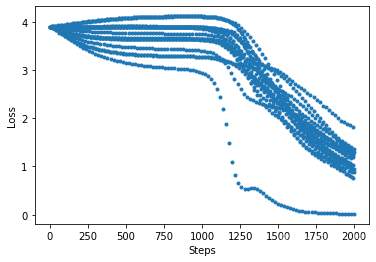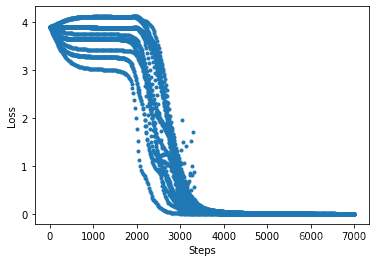技术实践丨体验量子神经网络在自然语言处理中的应用
Posted 华为云
tags:
篇首语:本文由小常识网(cha138.com)小编为大家整理,主要介绍了技术实践丨体验量子神经网络在自然语言处理中的应用相关的知识,希望对你有一定的参考价值。
摘要:本文从零带你体验量子神经网络在自然语言处理中的应用
本文分享自华为云社区《体验量子神经网络在自然语言处理中的应用》,原文作者:JeffDing。
本文从零带你体验量子神经网络在自然语言处理中的应用。
一、运行环境
CPU:Intel(R) Core(TM) i7-4712MQ CPU @ 2.30GHz
内存:4GB
操作系统:Ubuntu 20.10
MindSpore版本:1.2
二、安装Mindspore
参考官网安装文档:https://www.mindspore.cn/install/
安装MindQuantum参照文档 :https://gitee.com/mindspore/mindquantum/blob/r0.1/README_CN.md
通过Mindspore.__version__查看版本

三、体验量子神经网络在自然语言处理中的应用
1.环境准备
入包 import numpy as np import time from projectq.ops import QubitOperator import mindspore.ops as ops import mindspore.dataset as ds from mindspore import nn from mindspore.train.callback import LossMonitor from mindspore import Model from mindquantum.nn import MindQuantumLayer from mindquantum import Hamiltonian, Circuit, RX, RY, X, H, UN #数据预处理 def GenerateWordDictAndSample(corpus, window=2): all_words = corpus.split() word_set = list(set(all_words)) word_set.sort() word_dict = {w: i for i,w in enumerate(word_set)} sampling = [] for index, word in enumerate(all_words[window:-window]): around = [] for i in range(index, index + 2*window + 1): if i != index + window: around.append(all_words) sampling.append([around,all_words[index + window]]) return word_dict, sampling word_dict, sample = GenerateWordDictAndSample("I love natural language processing") print(word_dict) print('word dict size: ', len(word_dict)) print('samples: ', sample) print('number of samples: ', len(sample))运行结果:
[注意] 当前模拟器线程为 1。如果您的模拟速度较慢,请根据您的模型将 OMP_NUM_THREADS 设置为适当的数字。
{'I': 0, 'language': 1, 'love': 2, 'natural': 3, 'processing': 4}
word dict size: 5
samples: [[['I', 'love', ' language', 'processing'], 'natural']]
样本数:1
可知如上信息,我们得到该句子的词典大小为 5,能够产生一个样本点。
2.编码线路
def Genera**coderCircuit(n_qubits, prefix=''): if len(prefix) != 0 and prefix[-1] != '_': prefix += '_' circ = Circuit() for i in range(n_qubits): circ += RX(prefix + str(i)).on(i) return circ Genera**coderCircuit(3,prefix='e')运行结果:
RX(e_0|0)
RX(e_1|1)
RX(e_2|2)
我们通常用|0〉">|0〉|0〉和|1〉">|1〉|1〉来标记二能级量子比特的两个状态,由态叠加原理,量子比特还可以处于这两个状态的叠加态:
|ψ〉=α|0〉+β|1〉">|ψ〉=α|0〉+β|1〉|ψ〉=α|0〉+β|1〉
对于n">nn比特的量子态,其将处于2n">2n2n维的希尔伯特空间中。对于上面由5个词构成的词典,我们只需要⌈log25⌉=3">⌈log25⌉=3⌈log25⌉=3个量子比特即可完成编码,这也体现出量子计算的优越性。
例如对于上面词典中的“love”,其对应的标签为2,2的二进制表示为010,我们只需将编码线路中的e_0、e_1和e_2分别设为0">00、π">ππ和0">00即可。
#通过Evolution算子来验证 from mindquantum.nn import generate_evolution_operator from mindspore import context from mindspore import Tensor n_qubits = 3 # number of qubits of this quantum circuit label = 2 # label need to encode label_bin = bin(label)[-1:1:-1].ljust(n_qubits,'0') # binary form of label label_array = np.array([int(i)*np.pi for i in label_bin]).astype(np.float32) # parameter value of encoder encoder = Genera**coderCircuit(n_qubits, prefix='e') # encoder circuit encoder_para_names = encoder.parameter_resolver().para_name # parameter names of encoder print("Label is: ", label) print("Binary label is: ", label_bin) print("Parameters of encoder is: \\n", np.round(label_array, 5)) print("Encoder circuit is: \\n", encoder) print("Encoder parameter names are: \\n", encoder_para_names) context.set_context(mode=context.GRAPH_MODE, device_target="CPU") # quantum state evolution operator evol = generate_evolution_operator(param_names=encoder_para_names, circuit=encoder) state = evol(Tensor(label_array)) state = state.asnumpy() quantum_state = state[:, 0] + 1j * state[:, 1] amp = np.round(np.abs(quantum_state)**2, 3) print("Amplitude of quantum state is: \\n", amp) print("Label in quantum state is: ", np.argmax(amp))运行结果:
Label is: 2
Binary label is: 010
Parameters of encoder is:
[0. 3.14159 0. ]
Encoder circuit is:
RX(e_0|0)
RX(e_1|1)
RX(e_2|2)
Encoder parameter names are:
['e_0', 'e_1', 'e_2']
Amplitude of quantum state is:
[0. 0. 1. 0. 0. 0. 0. 0.]
Label in quantum state is: 2
通过上面的验证,我们发现,对于标签为2的数据,最后得到量子态的振幅最大的位置也是2,因此得到的量子态正是对输入标签的编码。我们将对数据编码生成参数数值的过程总结成如下函数。
def GenerateTrainData(sample, word_dict):
n_qubits = np.int(np.ceil(np.log2(1 + max(word_dict.values()))))
data_x = []
data_y = []
for around, center in sample:
data_x.append([])
for word in around:
label = word_dict[word]
label_bin = bin(label)[-1:1:-1].ljust(n_qubits,'0')
label_array = [int(i)*np.pi for i in label_bin]
data_x[-1].extend(label_array)
data_y.append(word_dict[center])
return np.array(data_x).astype(np.float32), np.array(data_y).astype(np.int32)
GenerateTrainData(sample, word_dict)运行结果:
(array([[0. , 0. , 0. , 0. , 3.1415927, 0. ,
3.1415927, 0. , 0. , 0. , 0. , 3.1415927]],
dtype=float32),
array([3], dtype=int32))
根据上面的结果,我们将4个输入的词编码的信息合并为一个更长向量,便于后续神经网络调用。
3.Ansatz线路
#定义如下函数生成Ansatz线路 def GenerateAnsatzCircuit(n_qubits, layers, prefix=''): if len(prefix) != 0 and prefix[-1] != '_': prefix += '_' circ = Circuit() for l in range(layers): for i in range(n_qubits): circ += RY(prefix + str(l) + '_' + str(i)).on(i) for i in range(l % 2, n_qubits, 2): if i < n_qubits and i + 1 < n_qubits: circ += X.on(i + 1, i) return circ GenerateAnsatzCircuit(5, 2, 'a')运行结果:
RY(a_0_0|0)
RY(a_0_1|1)
RY(a_0_2|2)
RY(a_0_3|3)
RY(a_0_4|4)
X(1 <-: 0)
X(3 <-: 2)
RY(a_1_0|0)
RY(a_1_1|1)
RY(a_1_2|2)
RY(a_1_3|3)
RY(a_1_4|4)
X(2 <-: 1)
X(4 <-: 3)
4.测量
def GenerateEmbeddingHamiltonian(dims, n_qubits): hams = [] for i in range(dims): s = '' for j, k in enumerate(bin(i + 1)[-1:1:-1]): if k == '1': s = s + 'Z' + str(j) + ' ' hams.append(Hamiltonian(QubitOperator(s))) return hams GenerateEmbeddingHamiltonian(5, 5)运行结果:
[1.0 Z0, 1.0 Z1, 1.0 Z0 Z1, 1.0 Z2, 1.0 Z0 Z2]
5.量子版词向量嵌入层
运行之前请在终端运行export OMP_NUM_THREADS=4
def QEmbedding(num_embedding, embedding_dim, window, layers, n_threads):
n_qubits = int(np.ceil(np.log2(num_embedding)))
hams = GenerateEmbeddingHamiltonian(embedding_dim, n_qubits)
circ = Circuit()
circ = UN(H, n_qubits)
encoder_param_name = []
ansatz_param_name = []
for w in range(2 * window):
encoder = Genera**coderCircuit(n_qubits, 'Encoder_' + str(w))
ansatz = GenerateAnsatzCircuit(n_qubits, layers, 'Ansatz_' + str(w))
encoder.no_grad()
circ += encoder
circ += ansatz
encoder_param_name.extend(list(encoder.parameter_resolver()))
ansatz_param_name.extend(list(ansatz.parameter_resolver()))
net = MindQuantumLayer(encoder_param_name,
ansatz_param_name,
circ,
hams,
n_threads=n_threads)
return net
class CBOW(nn.Cell):
def __init__(self, num_embedding, embedding_dim, window, layers, n_threads,
hidden_dim):
super(CBOW, self).__init__()
self.embedding = QEmbedding(num_embedding, embedding_dim, window,
layers, n_threads)
self.dense1 = nn.Dense(embedding_dim, hidden_dim)
self.dense2 = nn.Dense(hidden_dim, num_embedding)
self.relu = ops.ReLU()
def construct(self, x):
embed = self.embedding(x)
out = self.dense1(embed)
out = self.relu(out)
out = self.dense2(out)
return out
class LossMonitorWithCollection(LossMonitor):
def __init__(self, per_print_times=1):
super(LossMonitorWithCollection, self).__init__(per_print_times)
self.loss = []
def begin(self, run_context):
self.begin_time = time.time()
def end(self, run_context):
self.end_time = time.time()
print('Total time used: {}'.format(self.end_time - self.begin_time))
def epoch_begin(self, run_context):
self.epoch_begin_time = time.time()
def epoch_end(self, run_context):
cb_params = run_context.original_args()
self.epoch_end_time = time.time()
if self._per_print_times != 0 and cb_params.cur_step_num % self._per_print_times == 0:
print('')
def step_end(self, run_context):
cb_params = run_context.original_args()
loss = cb_params.net_outputs
if isinstance(loss, (tuple, list)):
if isinstance(loss[0], Tensor) and isinstance(loss[0].asnumpy(), np.ndarray):
loss = loss[0]
if isinstance(loss, Tensor) and isinstance(loss.asnumpy(), np.ndarray):
loss = np.mean(loss.asnumpy())
cur_step_in_epoch = (cb_params.cur_step_num - 1) % cb_params.batch_num + 1
if isinstance(loss, float) and (np.isnan(loss) or np.isinf(loss)):
raise ValueError("epoch: {} step: {}. Invalid loss, terminating training.".format(
cb_params.cur_epoch_num, cur_step_in_epoch))
self.loss.append(loss)
if self._per_print_times != 0 and cb_params.cur_step_num % self._per_print_times == 0:
print("\\repoch: %+3s step: %+3s time: %5.5s, loss is %5.5s" % (cb_params.cur_epoch_num, cur_step_in_epoch, time.time() - self.epoch_begin_time, loss), flush=True, end='')
import mindspore as ms
from mindspore import context
from mindspore import Tensor
context.set_context(mode=context.GRAPH_MODE, device_target="CPU")
corpus = """We are about to study the idea of a computational process.
Computational processes are abstract beings that inhabit computers.
As they evolve, processes manipulate other abstract things called data.
The evolution of a process is directed by a pattern of rules
called a program. People create programs to direct processes. In effect,
we conjure the spirits of the computer with our spells."""
ms.set_seed(42)
window_size = 2
embedding_dim = 10
hidden_dim = 128
word_dict, sample = GenerateWordDictAndSample(corpus, window=window_size)
train_x,train_y = GenerateTrainData(sample, word_dict)
train_loader = ds.NumpySlicesDataset({
"around": train_x,
"center": train_y
},shuffle=False).batch(3)
net = CBOW(len(word_dict), embedding_dim, window_size, 3, 4, hidden_dim)
net_loss = nn.SoftmaxCrossEntropyWithLogits(sparse=True, reduction='mean')
net_opt = nn.Momentum(net.trainable_params(), 0.01, 0.9)
loss_monitor = LossMonitorWithCollection(500)
model = Model(net, net_loss, net_opt)
model.train(350, train_loader, callbacks=[loss_monitor], dataset_sink_mode=False)
运行结果:
epoch: 25 step: 20 time: 36.14, loss is 3.154
epoch: 50 step: 20 time: 36.51, loss is 2.945
epoch: 75 step: 20 time: 36.71, loss is 0.226
epoch: 100 step: 20 time: 36.56, loss is 0.016
Total time used: 3668.7517251968384
打印收敛过程中的损失函数值:
import matplotlib.pyplot as plt plt.plot(loss_monitor.loss,'.') plt.xlabel('Steps') plt.ylabel('Loss') plt.show()
打印量子嵌入层的量子线路中的参数
net.embedding.weight.asnumpy()array([-6.4384632e-02, -1.2658586e-01, 1.0083634e-01, -1.3011757e-01,
1.4005195e-03, -1.9296107e-04, -7.9315618e-02, -2.9339856e-01,
7.6259784e-02, 2.9878360e-01, -1.3091319e-04, 6.8271365e-03,
-8.5563213e-02, -2.4168481e-01, -8.2548901e-02, 3.0743122e-01,
-7.8157615e-04, -3.2907310e-03, -1.4412615e-01, -1.9241245e-01,
-7.5561814e-02, -3.1189525e-03, 3.8330450e-03, -1.4486053e-04,
-4.8195502e-01, 5.3657538e-01, 3.8986996e-02, 1.7286544e-01,
-3.4090234e-03, -9.5573599e-03, -4.8208281e-01, 5.9604627e-01,
-9.7009525e-02, 1.8312852e-01, 9.5267012e-04, -1.2261710e-03,
3.4219343e-02, 8.0031365e-02, -4.5349425e-01, 3.7360430e-01,
8.9665735e-03, 2.1575980e-03, -2.3871836e-01, -2.4819574e-01,
-6.2781256e-01, 4.3640310e-01, -9.7688911e-03, -3.9542126e-03,
-2.4010721e-01, 4.8120108e-02, -5.6876510e-01, 4.3773583e-01,
4.7241263e-03, 1.4138421e-02, -1.2472854e-03, 1.1096644e-01,
7.1980711e-03, 7.3047012e-02, 2.0803964e-02, 1.1490706e-02,
8.6638138e-02, 2.0503466e-01, 4.7177267e-03, -1.8399477e-02,
1.1631225e-02, 2.0587114e-03, 7.6739892e-02, -6.3548386e-02,
1.7298019e-01, -1.9143591e-02, 4.1606693e-04, -9.2881303e-03],
dtype=float32)
6.经典版词向量嵌入层
class CBOWClassical(nn.Cell):
def __init__(self, num_embedding, embedding_dim, window, hidden_dim):
super(CBOWClassical, self).__init__()
self.dim = 2 * window * embedding_dim
self.embedding = nn.Embedding(num_embedding, embedding_dim, True)
self.dense1 = nn.Dense(self.dim, hidden_dim)
self.dense2 = nn.Dense(hidden_dim, num_embedding)
self.relu = ops.ReLU()
self.reshape = ops.Reshape()
def construct(self, x):
embed = self.embedding(x)
embed = self.reshape(embed, (-1, self.dim))
out = self.dense1(embed)
out = self.relu(out)
out = self.dense2(out)
return out
train_x = []
train_y = []
for i in sample:
around, center = i
train_y.append(word_dict[center])
train_x.append([])
for j in around:
train_x[-1].append(word_dict[j])
train_x = np.array(train_x).astype(np.int32)
train_y = np.array(train_y).astype(np.int32)
print("train_x shape: ", train_x.shape)
print("train_y shape: ", train_y.shape)
train_loader = ds.NumpySlicesDataset({
"around": train_x,
"center": train_y
},shuffle=False).batch(3)
net = CBOWClassical(len(word_dict), embedding_dim, window_size, hidden_dim)
net_loss = nn.SoftmaxCrossEntropyWithLogits(sparse=True, reduction='mean')
net_opt = nn.Momentum(net.trainable_params(), 0.01, 0.9)
loss_monitor = LossMonitorWithCollection(500)
model = Model(net, net_loss, net_opt)
model.train(350, train_loader, callbacks=[loss_monitor], dataset_sink_mode=False)运行结果:
train_x shape: (58, 4)
train_y shape: (58,)
epoch: 25 step: 20 time: 0.077, loss is 3.156
epoch: 50 step: 20 time: 0.095, loss is 3.025
epoch: 75 step: 20 time: 0.115, loss is 2.996
epoch: 100 step: 20 time: 0.088, loss is 1.773
epoch: 125 step: 20 time: 0.083, loss is 0.172
epoch: 150 step: 20 time: 0.110, loss is 0.008
epoch: 175 step: 20 time: 0.086, loss is 0.003
epoch: 200 step: 20 time: 0.081, loss is 0.001
epoch: 225 step: 20 time: 0.081, loss is 0.000
epoch: 250 step: 20 time: 0.078, loss is 0.000
epoch: 275 step: 20 time: 0.079, loss is 0.000
epoch: 300 step: 20 time: 0.080, loss is 0.000
epoch: 325 step: 20 time: 0.078, loss is 0.000
epoch: 350 step: 20 time: 0.081, loss is 0.000
Total time used: 30.569124698638916
收敛图:

由上可知,通过量子模拟得到的量子版词嵌入模型也能很好的完成嵌入任务。当数据集大到经典计算机算力难以承受时,量子计算机将能够轻松处理这类问题。
以上是关于技术实践丨体验量子神经网络在自然语言处理中的应用的主要内容,如果未能解决你的问题,请参考以下文章